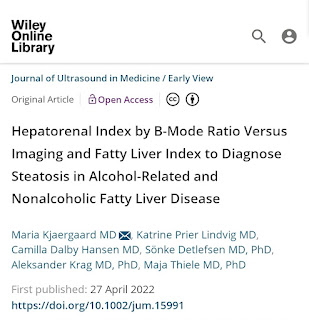Abstract
Objectives
We aimed to evaluate the accuracy of the hepatorenal index by B-mode ratio to diagnose hepatic steatosis, compared to ultrasound steatosis score, controlled attenuation parameter, and the fatty liver index using histology as the gold standard.
Methods
We prospectively included participants with alcohol-related or nonalcoholic fatty liver disease for same-day noninvasive investigations and liver biopsy.
Results
We included 137 participants, 72% male, median age 60 years (53–65) and body mass index 32 kg/m2 (28–38). Eighty percent had steatosis (S0/S1/S2/S3 = 20/37/24/19%). B-mode ratio had moderate diagnostic accuracy for any steatosis (≥S1, area under the receiver operating characteristics curve [AUROC] = 0.79; 95% confidence interval 0.70–0.88), significant steatosis (≥S2, AUROC = 0.76; 0.66–0.85), and severe steatosis (=S3, AUROC = 0.74; 0.62–0.86), independent of disease etiology. The cutoff values to rule-out and rule-in any steatosis were 1.09 and 1.45. While B-mode ratio and controlled attenuation parameter correlated poorly, their diagnostic accuracies were comparable to each other and to ultrasound steatosis scoring. Fatty liver index did not differ from B-mode ratio in detecting any steatosis but had poor accuracy to detect higher steatosis grades. B-mode ratio measurements failed in 12% of patients, compared to 1% for ultrasound steatosis scoring and 2% for controlled attenuation parameter.
Conclusion
The hepatorenal index by B-mode ratio diagnose steatosis with moderate accuracy in patients with alcohol-related or nonalcoholic fatty liver disease, comparable to B-mode ultrasound steatosis scoring and controlled attenuation parameter. However, its clinical use is limited by a high failure rate.


Không có nhận xét nào :
Đăng nhận xét